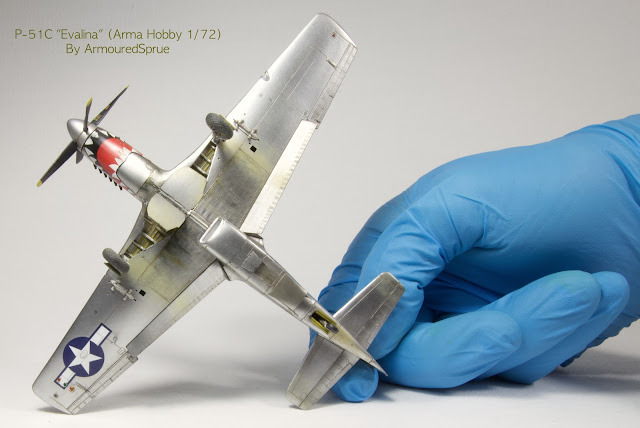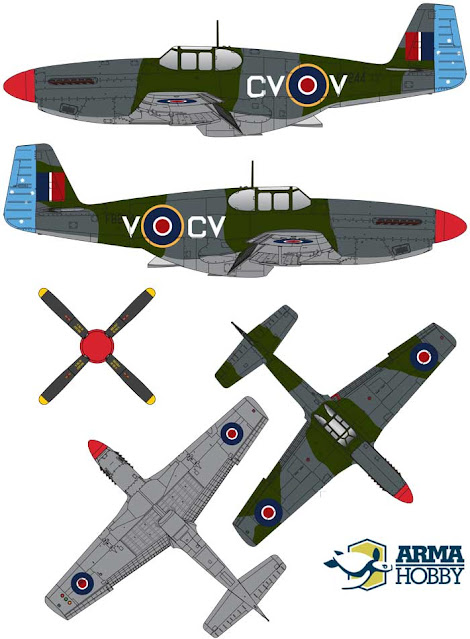P-51C-11-NT 44-10816 “Evalina” (Arma Hobby 1/72)
26th FS, 51st FG, 1st Lieutenant Oliver E. Strawbridge
China, January 1945
Kit: Arma Hobby - Expert Set #70038 Scale: 1/72
Aftermarket:
- EzLine for the antenna.
- BarracudaCast Item: BR72497 P-51 Mustang Diamond Tread pattern resin main wheels.
The kit is the best P-51B available in 1/72nd scale.
A P-51C with the charming name “Evalina” was the first and, as it turned out, last fully airworthy North American Mustang to be captured by the Japanese. Intensive tests followed by demonstration flights at combat units convinced both veterans and commanders of the Imperial Japanese Army Air Force that their most recent “acquisition” was a truly fantastic aircraft – the fulfilment of every fighter pilot’s dreams.
The North American P-51C-11-NT Mustang with registration number 44-10816 (manufactured at the Dallas plant in Texas as 111-28949) was the personal aeroplane of First Lieutenant Oliver E. Strawbridge. At the turn of 1945, the fighter was stationed in China with the 26th Fighter Squadron, itself an element of the 51st Fighter Group. The unit’s combat trail had started in India and proceeded through Burma and China, ending in French Indochina, a territory that comprised present-day Vietnam, Laos and Cambodia.
“EVALINA” Ends up in Japanese hands
In truth, the circumstances of the incident have still not been fully clarified. We do know that on 16 January 1945 the pilot landed “Evalina” on the Chinese airfield of Suchin, which was still held by the Japanese. While the Americans concluded that this was the result of a navigational error, Japanese sources mention an emergency landing – and then muddle the story still further. Namely, some maintain that the aircraft belly-landed in a rice paddy near the base, but according to others the fighter made a normal landing necessitated by a technical fault.
Practically all historians reject the former version of events, logically assuming that Japanese ground crews would have been incapable of repairing damage sustained by an Allied fighter during a wheels up landing made in difficult terrain (especially as there are no extant documents suggesting that such repairs had actually been performed). This would appear to be supported by the fact that later, when “Evalina’s” tail wheel leg suffered only slight damage, it was simply left locked in the down position. Whatever the case may have been, the chance acquisition of a virtually brand-new and fully functional Mustang was a godsend to the IJAAF. It was no surprise, therefore, that the aircraft was collected and flown to Japan, where it underwent detailed testing, by one of the leading aces of the Imperial Japanese Army Air Force – Major Kuroe.
The Riddle of “EVALINA”
The final act of our story took place several dozen years after the end of the war. In the nineteen eighties and nineties, growing interest in the wartime activities of the Imperial Japanese Army Air Force led to the publication of numerous press articles and monographs. “Evalina” also became rather widely known, both among World War II history buffs and modellers.
Strangely – albeit in a sense logically – it was taken for granted that since the aircraft had been regularly flown by Oliver E. Strawbridge, he must have been the leading protagonist of the whole unfortunate event. Whereas… Around the mid-nineties, First Lieutenant Strawbridge’s granddaughter, Sara, finally shed some light on the riddle. Namely, she stated that although she had never met her grandfather (due to family reasons), she knew with absolute certainty that he had not been the pilot of the Mustang on that fateful day of 16 January. Furthermore, she informed that her grandfather had served in the USAAF until the very end of the conflict and had never been a Japanese POW. From what she recollected, he had died in 1987 in the USA. The name given to the aircraft, “Evalina”, was that of his then girlfriend. Their love fizzled out, however, and after the war First Lieutenant Strawbridge married a woman by the names of Ruth Anne.
The topic was taken up by a few historians, with the renowned Henry Sakaida first and foremost among them. Finally, it was determined that the Mustang had been piloted by First Lieutenant Sam McMillan, Strawbridge’s friend from the 26th Fighter Squadron. Captured and imprisoned by the Japanese, he survived the war and returned home. When this research was being conducted, First Lieutenant McMillan was still alive, living in his hometown in Connecticut. However, due to his age and state of health, he did not assist in clarifying the circumstances of the incident. Sakaida published his conclusions in “Flight Journal” magazine sometime around the year 2000 (although it would seem that they are not widely known today). Ms. Susan Strawbridge-Bryant assisted in collecting a considerable part of the material.
(Text extracted from: Arma Hobby kits Blog, History. https://armahobbynews.pl/en/blog/2021/11/19/the-chequered-fate-of-the-p-51c-mustang-called-evalina/)
Modifications to the kit:
- New resin wheels for the Diamond Tread pattern as seen in the photos.
- The antenna wire was made using EzLine super fine.
- Paint scheme:
- SMS Lacquer - Metallic Aluminium for overall fuselage.
- SMS Lacquer - Stainless Steel for exhaust panel.
- SMS Lacquer - Metallic Silver for upper and ventral wing panels.
- Gunze Acrylic - Olive Drab 1 (H52) for anti-glare panel.
Reference photos

















































